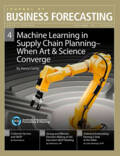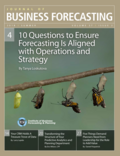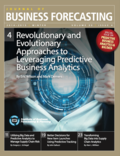 Cart
(0)
Sign In
Cart
(0)
Sign In
- Type of content
- All Knowledge
- Analytics
- Process
- Technology
- People
15
Articles Available
There’s a lot of excitement lately about AI, new models, and machine learning algorithms and the accompanying idea that they will replace all human judgement. This misconception may be due to lack of understanding about how all the tools and methods now available fit together, and how we need all of them if we’re to forecast all datasets accurately. In this article we will look at the full spectrum of forecasting methods from pure judgment to machine learning, and classify each of them so that they are easy to understand. I also provide an explanation of each of the broader classes of methods, so demand planners can add different models to their toolkit, knowing when to use which one for maximum effect.
Summer 2019
6
This article discusses the important AI subset of Machine Learning and its application to the area of supply chain planning and optimization. It defines machine learning and how it relates to other advanced analytic methods including AI; predictive, prescriptive and cognitive analytics; algorithmic optimization; and cognitive computing. It also provides a list of potential improvement areas to help practitioners build a business case for machine learning to secure the investment required to benefit from this game-changing technology.
Spring 2019
5
Most forecasting approaches are based on the idea that a forecast can be improved if the underlying factors are identified then forecasted separately. It stands to reason, then, that with conventional time series approaches that extract information from historical observations, we may gain insights by isolating and modeling elements like seasonality. In this article, I explore how transforming historical data with multi-cluster time series analysis allows us to gather additional information about seasonality. I discuss a newly introduced modelling approach that combines information from many different clusters of attributes and levels of aggregation for improved seasonal profiles, and consequently allows us to build more robust forecasts.
Fall 2018
The second machine age is allowing us to understand and shape our environments using computers and other digital advancements. We’re now seeing unsupervised learning systems that learn faster, require less data, and achieve impressive performance. These supervised and unsupervised intelligent automation techniques can drive automation and enrich their domain experts — not replace them by helping them work more effectively. Intelligent automation driven by Artificial Intelligence (AI) and machine learning (ML) are disrupting the way companies do business. The rapid deployment of automation is helping us set new standards of efficiency, speed, and functionality. Intelligent automation will help demand planners to sense and synthesize vast amounts of information boosting the FVA process guiding demand planners with surgical precision to work smarter.
Fall 2018
In the late 1960s and early 1970s, Kahneman and Tversky carried out a series of breakthrough studies that gave rise to the field of behavioral economics, and changed how judgment should be viewed. Few of us are aware of the significance of Kahneman and Tversky’s findings, namely that human judgment is flawed and, in terms of making predictions about the future, mathematics tends to outperform human judgment close to 100 percent of the time. They used data and analytics to find true patterns in human behavior that replace false assumptions in a number of areas of study. Similarly, demand analysts and planners need to find the true patterns in human judgment to replace the false ones that govern our demand forecasts and plans.
Summer 2018
Using real-time information as it is streaming in from connected devices on the Internet of Things (IoT), edge analytics is gaining attention as the IoT has become more widespread, streaming data from manufacturing machines, online purchases, and mobile and other remote devices. Using analytic algorithms as data are generated, at the edge of the corporate network, companies can set constraints to determine what information is worth sending to the Cloud, to a demand signal repository, or other data repositories for later use. The key benefit of edge analytics is the ability to analyze data as they are generated, which decreases latency in the decision-making process as the data are collected. Rather than designing consolidated data systems where all the data are sent back to an enterprise data warehouse (or data lake) in a raw state, where they have to be cleaned and analyzed before being of any value, why not do everything at the edge of the system, including demand forecasting, using advanced algorithms or machine learning? Are you stuck in a vicious cycle of planning demand using two-to-four-week-old data, or are you conducting real-time demand execution anticipating demand at the edge?
Winter 2017-2018
With Artificial Intelligence, Machine Learning, and Augmented Reality, we cannot help but wonder if the reality is that our roles will be replaced by CPUs. While I do not think we will be replaced by robots in near future, there is an evolution happening today. In this article, we will look at the transformation of the demand planner of today to the data scientist of tomorrow, and how we may be able to start planning for how to be prepared when we get there.
Winter 2017-2018
Analytics-driven forecasting means more than measuring trend and seasonality. It includes all categories of methods including more advanced methods, such as artificial intelligence, but not necessarily deep learning algorithms. Expert systems are an integral part of artificial intelligence, also known as “symbolic artificial intelligence” (AI), which is designed to think like a human. AI is differentiated from “sub-symbolic artificial intelligence,” which includes the newly revived research area of neural networks and deep learning. Even with all the buzz about AI and machine learning (ML), not many are using either for demand forecasting, if they do, it’s on a one-off basis, not on a large scale across the entire business product hierarchy. In fact, many companies feel that AI and ML is the new demand forecasting “easy button,” which I remind them only works in those Staples commercials. You still need data scientists to monitor and tweak models using analytics-driven methods to make corrections if something dramatically changes. And demand planners are needed to own and manage the demand planning process.
Fall 2017
The digital revolution has affected all aspects of business, including supply chains. The Internet of Things (IoT), with its network of devices embedded with sensors is now connecting the consumer to the factory. Technologies such as RFID, GPS, event stream processing (ESP), and analytics are combining to help companies to transform their existing supply chain networks into more flexible, open, agile, and collaborative digital-driven models. Digital supply chains enable business process automation, organizational flexibility, and digital management of corporate assets.
Summer 2016
3
Multiple regression is, by far, the most widely used statistical technique in business. This research develops a multiple regression model to predict U.S. citizen’s outbound travel to Europe.
Fall 2015
2
This column discusses Predictive Business Analytics (PBAs), the “Big Data” area that the IBF has recently added to its focus. The area is a natural extension to the IBF’s forecasting and planning charter, and represents where innovation will be needed to take advantage of integrated supply-demand signals in a supply chain. A four-layer stacked approach to developing PBAs is discussed and several examples are given.
Winter 2014-2015
5
The emphasis of this article is how Predictive Analytics/Big Data can be used most productively in managing supply chain. They can be used to determine what happened, why it happened, and to develop a plan for change. Based on pre-defined business rules, they can identify where action is needed, they can
help to prepare more accurate forecasts, and, above all, they can help to determine the best course of action with what-if analysis. The article also describes the process to transform successfully the mass of information into analytics to make better decisions in a timely manner.
Winter 2014-2015
5
The importance of analytics to a supply chain organization will become the top priority and investment in the next few years. The sheer volume and complexity of today’s data are challenging enough, but top organizations of tomorrow will need to turn these data into useful insights quicker and for better decision making to create a competitive advantage. Companies need a new breed of talent, deployment models, and technologies. We cannot
simply cobble together existing pieces. What we need is an evolution—and maybe a revolution—in how to look at and use Predictive Analytics. This article describes strategies to understand the basics of Predictive Analytics, and the way to navigate the potential capabilities of demand planning of tomorrow.
Winter 2014-2015
6
With our new norms in Operations Management, including globalization of our
supply chains, increasing demand and supply uncertainty, and supply chain network complexity, product proliferation,
process risk, changes in environmental rules and regulations, extreme weather, big risks and Big Data, our supply chain
dynamics have changed significantly. At the same time, there is substantial growth in data to deal with. The most
current estimates are that more than 15 petabytes of information (1 petabyte = 15 million gigabytes) of new data are
collected every day. That’s more than eight times the combined information located in all U.S. libraries! This article
discusses how companies are leveraging Big Data and Predictive Analytics to mitigate and manage supply chain risks.
Winter 2014-2015
7
The variability and high failure rates of new item launches are often drivers of service issues, unfavorable cost variances, and excess inventories. Combining Predictive Analytics with a rigorous tracking and decision-making process (Predictive Tracking) can minimize these risks and ensure the proper balance of demand and supply. This process begins with a commitment that Demand Planning must be responsible for service, cost, and inventory associated with the launch, and it requires a high-performing relationship with other functions. It is centered on the concept that analytics and communication tactics must be well organized, forcing discussions within weeks of a new item launch that are traditionally completed several months after, when it is too late to take action.
Winter 2014-2015
4
















